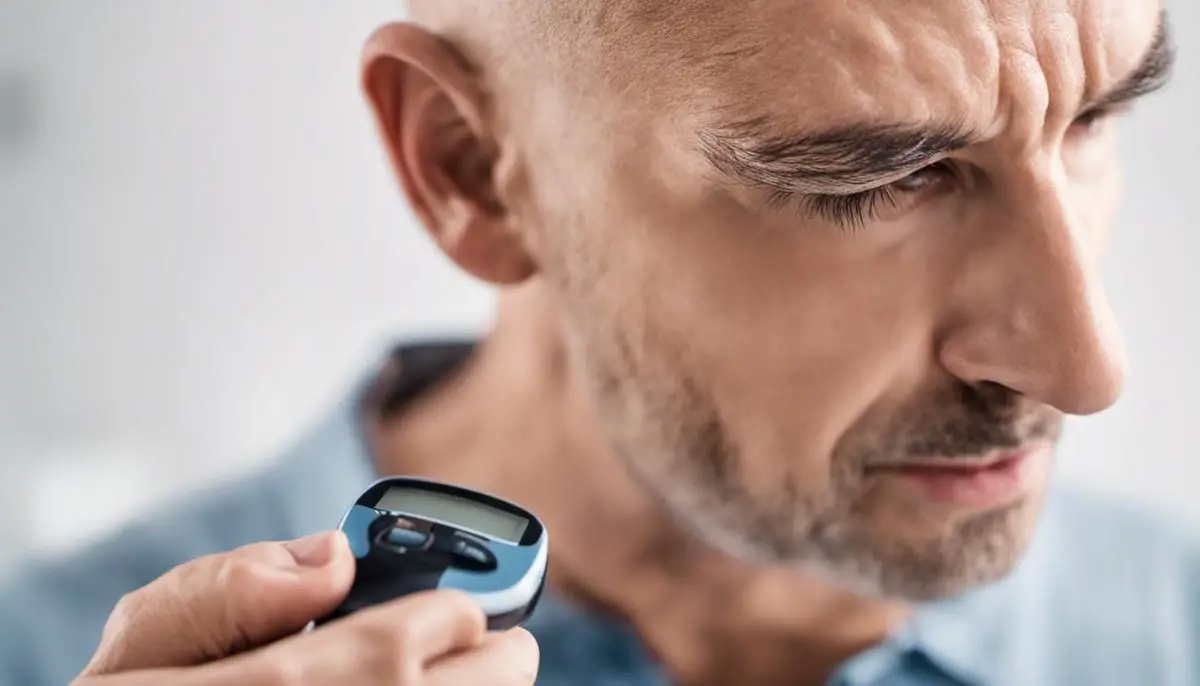Understanding chronic health conditions is crucial for effective management and optimum life quality. Two common conditions that significantly impact a large demographic are diabetes and male pattern baldness. While each presents its unique challenges, careful observation reveals a compelling connection between the two. Diabetes, a condition characterized by high blood sugar levels due to the body’s inability to produce or use insulin effectively, affects a staggering portion of the global population. On the other hand, male pattern baldness, a form of hair loss that commonly occurs in men as they age, is somewhat more nuanced, attributable to a combination of genetics and hormonal changes. This discourse aims to unpack these health concerns, from a basic understanding to the startling overlaps, risk factors, and promising treatment options currently available.
Overview of Diabetes and Male Pattern Baldness
Understanding Diabetes
Diabetes is a chronic medical condition that affects the body’s ability to regulate blood sugar levels. Insulin, a hormone produced in the pancreas, regulates this process. However, individuals with diabetes either cannot produce enough insulin (Type 1), cannot effectively use the insulin produced (Type 2), or experience both issues, as in the case of Gestational diabetes, which appears during pregnancy.
According to the American Diabetes Association, 10.5% of the United States population, or roughly 34.2 million people, have diabetes. Both men and women are affected, though males are slightly more likely to develop the disease. Diabetes incidence can increase with age, obesity, and sedentary lifestyle, although genetics and ethnicity also play significant roles.
Common symptoms of diabetes include frequent urination, unquenchable thirst, weight loss, fatigue, blurred vision, and slow healing of wounds. If left uncontrolled, long-term complications may include cardiovascular disease, kidney damage, vision loss, and nerve damage.
Treatment for diabetes typically involves a comprehensive approach, including dietary modifications, regular physical activity, blood sugar monitoring, and insulin therapy or other medications as necessary.
Exploring Male Pattern Baldness
Male pattern baldness, also known as androgenetic alopecia, is the most prevalent type of hair loss in men. It is primarily attributed to genetics and the male hormone dihydrotestosterone (DHT). The condition typically emerges with age, often displaying as a receding hairline and hair loss on the crown of the head.
According to the American Hair Loss Association, about two-thirds of American men will experience some degree of hair loss by the age of 35, and by age 50, approximately 85% of men will have significant hair thinning. Although male pattern baldness predominantly impacts Caucasian men, it can affect males of all racial and ethnic groups.
Male pattern baldness presents progressively, often starting with a receding hairline followed by thinning around the crown and temples. While it is primarily a cosmetic issue, it can impact men’s self-esteem and mental health.
Treatments aim to slow hair loss and improve hair coverage. Topical solutions like minoxidil (Rogaine) and oral drugs like finasteride (Propecia) are FDA-approved treatments for male pattern baldness. Surgical options like hair transplants are also available when medical management is inadequate or ineffective.
Exploring the Link Between Diabetes and Male Pattern Baldness
Understanding the potentially intricate relationship between diabetes, particularly Type 2, and male pattern baldness is a subject of ongoing research. Some findings propose that insulin resistance, a common characteristic of Type 2 diabetes, may disrupt hair growth, leading to thinning or balding. Additionally, the stress and hormonal changes associated with managing chronic conditions like diabetes are known to possibly accelerate hair loss.
Some medications for managing diabetes have hair loss listed as a potential side effect. However, it is essential to note that hair loss in individuals diagnosed with diabetes is not purely a result of male pattern baldness. A combination of various factors such as age, genetic factors, stress levels, poor circulation, and hormonal imbalances can trigger hair loss.
The impacts of both these conditions can be lessened through proactive measures and early intervention. Regular physical activities, maintaining a nutrient-rich diet, routine health check-ups, stress management, and prescribed medications are crucial strategies to preserve overall health and wellbeing.

The Link Between Diabetes and Hair Loss
Understanding the Probable Consequence of Diabetes: Hair Loss
Diabetes, a chronic disease affecting millions of individuals worldwide, is associated with varying complications and co-occurring conditions. Hair loss, specifically male pattern baldness or medically known as Androgenetic Alopecia, is one such condition. A body of research suggests a correlation between diabetes and hair loss, indicating that Androgenetic Alopecia could be a common manifestation in men living with diabetes.
Mechanisms Behind Diabetes-Induced Hair Loss
Hair loss in individuals with diabetes may stem from a multitude of factors. Diabetes often leads to poor blood circulation, resulting in inadequate nutrient supply to the hair follicles. This can weaken the follicles and cause hair to fall out. High blood sugar levels associated within uncontrolled diabetes can also impact the overall health of hair, damaging it and leading to hair loss.
Additionally, diabetes-related stress and hormonal imbalance can contribute to hair loss. It’s worth noting that autoimmune reactions linked to Type 1 Diabetes can directly attack hair follicles, leading to a type of hair loss known as alopecia areata.
Male Pattern Baldness and Diabetes – The Link
Male Pattern Baldness (MPB) is a genetic condition that affects many men as they age. MPB is caused primarily by a sensitivity to androgens—the male hormones—which impacts the growth cycle of hair follicles and consequently, leads to thinning and eventual hair loss.
Several research studies have pointed to a correlation between this form of hair loss and the development of diabetes. A study published in the European Journal of Epidemiology found that individuals with MPB have a 30-40% increased risk of insulin resistance— a condition that often precedes the development of type 2 diabetes—compared to those without hair loss.
However, it is important to clarify that while research has discovered a link, male pattern baldness does not causally lead to diabetes. It is considered more of a risk indicator rather than a direct cause.
Treatment and Management
Effective management of diabetes — through a combination of medications, dietary changes, and lifestyle habits — can help mitigate associated hair loss. If hair loss is severe, doctors may recommend treatments like minoxidil or finasteride, proven treatments for Male Pattern Baldness.
It’s also crucial to manage stress levels, as stress can exacerbate both diabetes and hair loss. Consulting with a health professional can provide a clear path to tackle these concerns effectively.
A Concluding Remark
Understanding the links between diabetes and male pattern baldness is crucial to managing these conditions effectively and minimizing complications. Knowledge about these interconnected health issues is the key to proactive and informed healthcare.

Risk Factors for Diabetes-Induced Hair Loss
Understanding the Links: Diabetes and Hair Loss in Men
Possessing a status as a metabolic disorder, diabetes is associated with various health problems, including an often-neglected one: hair loss. In men, the condition of diabetes can intensify the effects of male-pattern baldness – a usual form of hair loss starting with receding hairlines, and then thinning at the crown.
How exactly diabetes influences hair loss is not yet fully clear, although it’s generally believed to be linked with elevated blood sugar levels. Over time, this high level could inflict damage on the blood vessels, compromising the supply of blood and nutrients to hair follicles. As a result, these follicles may weaken and eventually die, causing hair loss.
Role of Age and Genetics
Age is a significant risk factor for both male pattern baldness and diabetes. As men age, their risk of developing Type 2 diabetes increases, and so does the potential for hair thinning and loss. Genetics also plays a crucial role. Men who have a family history of diabetes are more likely to develop the disease, and the same applies to male pattern baldness.
Diet and Lifestyle
A diet high in processed and sugary foods can increase blood sugar levels, leading to a heightened risk of diabetes. Such dietary habits also impact overall health, including hair health. A lack of essential nutrients can weaken hair follicles and thus lead to hair loss.
Similarly, lifestyle habits like smoking and avoiding exercise can escalate the risk of diabetes and hair loss. Smoking damages small blood vessels, restricting blood flow to various parts of the body, including the scalp. Lack of physical activity, on the other hand, can lead to weight gain and increased insulin resistance, both risk factors for diabetes.
Preventative Strategies
Proactive lifestyle modifications can significantly reduce the risk of both diabetes and hair loss. Embracing a balanced diet that includes lean proteins, fruits, vegetables, and wholesome grains can help to regulate blood sugar levels, while also offering the essential nutrients that support healthy hair growth.
Regular physical exercise not only aids in maintaining an optimal weight, but it also enhances insulin sensitivity which leads the body to utilize insulin more efficiently. Additionally, it is advised to refrain from smoking and limit the consumption of alcohol.
For individuals with a familial history of diabetes or male pattern baldness, periodic screenings may aid in the early detection of these conditions. Medicines such as Minoxidil and Finasteride may be effective in slowing or preventing hair loss, and proper management of diabetes can lead to improved hair health. However, it is important to consult a healthcare professional before commencing any new medication or treatment regimen.

Management and Treatment Options
Understanding Diabetes and Male Pattern Baldness
Diabetes is a chronic medical condition that affects the body’s capability to process blood glucose, also known as blood sugar. This disease can lead to other health issues, one of the notable ones being hair loss. In particular, it has been observed that poorly controlled diabetes can result in conditions such as alopecia areata, where patches of hair fall out, telogen effluvium, and most commonly, male pattern baldness.
Medical Treatments: Traditional Therapies and Recent Advancements
Medical treatments for diabetes-induced hair loss primarily revolve around managing the underlying diabetes condition. Maintaining the correct blood glucose level can dramatically slow hair loss and even encourage hair regrowth in some cases. Diabetes medications like metformin and insulin injections are the cornerstones of maintaining blood sugar. Other treatments specifically targeting hair loss include over-the-counter products like minoxidil (Rogaine) and finasteride (Propecia), drugs that stimulate hair follicles to promote growth and prevent further thinning. These treatments work best for those in the early stages of hair loss.
The use of laser therapy is a newer technology in treating hair loss. Low Level Laser Therapy (LLLT) or red light therapy utilizes specific wavelengths of light to stimulate cellular activity, promoting hair growth. Various studies indicate that LLLT is an effective treatment for both male pattern baldness and hair loss caused by medical conditions, including diabetes.
Lifestyle Changes: Diet and Exercise
Adopting a balanced diet, regular physical exercise, and a reduced stress lifestyle plays a significant role in managing diabetes and its accompanying hair loss. Consuming foods rich in proteins, Omega-3 fatty acids, iron, and vitamins – particularly biotin, can support hair growth. Regular physical activity can help control blood sugar levels and manage body weight, both key factors in managing diabetes effectively.
Quitting smoking is also recommended as smoking constricts blood vessels, impairing circulation and worsening diabetes control. Decreased blood flow can restrict the amount of nutrients reaching the hair follicles, inhibiting hair growth and exacerbating hair loss.
Other Management Options: Hair Transplants and Scalp Micropigmentation
In more severe hair loss cases, surgical interventions like hair transplants might be recommended. During a transplant, hair follicles are removed from a denser growth area (usually the back of the head) and transplanted into thinning or balding areas.
For those unwilling or unable to undergo surgery, scalp micropigmentation (SMP) is an alternative option. This is a non-surgical procedure where natural pigments are applied at the epidermal level of the scalp, creating the appearance of natural hair follicles.
When considering treatment options for any health condition, mutual discussions with your healthcare providers are critical to determine the most suitable management course based on individual needs and conditions. It’s worth remembering that the effectiveness of a treatment can vastly differ from person to person, as it significantly depends on the unique aspects of each individual’s biological makeup and health status.

Expert Insights and Emerging Research
Understanding the Link: Diabetes and Male Pattern Baldness
Science is continuously unearthing evidence that implies a connection between diabetes and male pattern baldness. The hypothesized link is largely attributed to the higher insulin levels typically found in people suffering from diabetes. These elevated insulin levels could potentially initiate body-wide inflammation, negatively impacting the scalp’s hair follicles and triggering hair loss.
A study conducted in 2018 and published in the esteemed Journal of the American Academy of Dermatology unearthed that men experiencing male pattern baldness had a 30% increased risk of developing diabetes compared to those who didn’t have this hair loss pattern. This intriguing find has pushed scientists to delve deeper into unearthing the hidden ties between these two seemingly unrelated conditions.
The Role of Genetics
Genetics appear to play a significant role in both diabetes and male pattern baldness. Certain gene mutations appear to increase your risk for both conditions. For example, TCF7L2 gene variations have been linked to both type 2 diabetes and male pattern baldness.
Moreover, recent studies have identified a novel gene, named HDAC9, that influences both male pattern baldness and type 2 diabetes. It’s believed that both of these conditions can arise from a common genetic background, albeit the exact mechanisms still remain largely elusive.
Understanding Hormonal Balance
Hormonal balance plays a crucial role in the development of both diabetes and male pattern baldness. Diabetes and baldness have been linked to an imbalance of androgen hormones in the body. More specifically, Dihydrotestosterone (DHT) high levels can cause shrinkage of the hair follicles, leading to thinning of hair or hair loss.
An imbalance of insulin, a hormone that regulates blood sugar levels, is also a hallmark of diabetes, and research has shown that this imbalance can adversely affect the hair growth cycle.
Future Treatments and Research
Based on these findings, researchers are hopeful about the development of future treatments that can address both conditions simultaneously. For example, drugs that control insulin and androgen hormone levels might be future therapeutic strategies for both diabetes and male pattern baldness.
Moreover, with the advancement in genomic science and the deployment of genome-wide association study(GWAS), future research could possibly uncover other shared links and genetic pathways between diabetes and male pattern baldness. This will allow precision medicine where interventions can be tailored to individuals based on their genetics.
Diet, Lifestyle and Prevention
A healthy lifestyle and diet may also reduce your risk for developing both conditions. Regular exercise, a balanced diet high in fruits, vegetables, lean proteins, and whole grains, along with avoidance of tobacco and alcohol, can contribute significantly to preventing both male pattern baldness and diabetes. Scientists are still studying whether specific foods or natural compounds could have positive effects on hair growth in individuals suffering from male pattern baldness.
Last,ly, even though these two conditions are related, having one does not necessarily mean you will develop the other. It simply indicates that individuals with these conditions may have an increased risk and should take appropriate steps to monitor and manage them.

Diabetes and male pattern baldness, seemingly disparate health conditions, share a more profound connection than initially perceived. As underscored in the preceding discourse, diabetic men face higher vulnerability to hair loss, necessitating understanding and recognition of the associated risk factors for prevention and efficient management. Promisingly, the health sector offers an array of treatments matured over years of scientific exploration, complemented by lifestyle adjustments that can significantly reduce the impact of these conditions. As research advances and newer technologies debut in the medical field, our understanding of the correlation between diabetes and male pattern baldness will evolve, bolstering the journey towards more effective treatments and perhaps, one day, a complete solution.

Thank you for being of assistance to me. I really loved this article.
Thank you for writing this post. I like the subject too.
Thank you for sharing this article with me. It helped me a lot and I love it.
Thanks for posting. I really enjoyed reading it, especially because it addressed my problem. It helped me a lot and I hope it will help others too.
Great beat ! I would like to apprentice while you amend your web site, how could i subscribe for a blog site? The account helped me a acceptable deal. I had been a little bit acquainted of this your broadcast provided bright clear concept
best price for viagra 100mg
is cialis a controlled substance
cialis windsor canada pharmacy